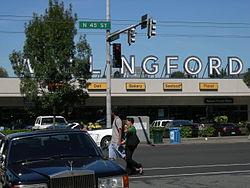Wallingford's business district extends along North 45th Street, from Stone Way North in the west to Sunnyside Avenue North in the east, and features the QFC grocery store, many small shops, three banks, three pharmacies, a few taverns and bars, the Wallingford Center (the former Interlake Elementary School, now turned into shops and apartments), and numerous restaurants (including the first Dick's Drive-In, founded 1954).
Notable structures and places
Public spaces include Gas Works Park, [6] Meridian Playground, Wallingford Center shopping mall, Wallingford branch of Seattle Public Library and Wallingford playfield. Gas Works Park on Lake Union borders the Burke-Gilman Trail and provides a panoramic extension into Lake Union, with a playground added in 2018 as part of the 2009 parks levy. The nearby North Transfer Station, a waste sorting center, was rebuilt in 2016 and includes a small park and playground. [7]
Meridian Playground features a former Roman Catholic home for wayward girls called the Good Shepherd Center, now a shared community space run by Historic Seattle. Major tenants include Tilth Alliance, Meridian School, the Wallingford Community Senior Center, and the Chapel performance space, which features the Wayward Music Series. Wallingford Playfield borders Hamilton International Middle School and features views and a wading pool open in summer months. To the north lies Lower Woodland Park, which features athletic fields, a skate park, tennis courts, and connections to the Woodland Park Zoo and Green Lake.
Wallingford is home to several community organizations. The Wallingford Neighborhood Office, located behind the CVS helps organize local events. The Wallingford Community Council meets the first Wednesday every month in the Good Shepherd Center and engages the community with government organizations. Sustainable Wallingford is a residents group dedicated to sustainable living. Tilth Alliance runs the public gardens and plant sales at the Good Shepherd Center. Solid Ground (formerly The Fremont Public Association) is colocated with the Wallingford Branch of the Seattle Public Library and runs a food bank and family support services. The Wallingford Boys and Girls club provides a safe, social space for kids and teens, while the Wallingford Community Senior Center provides a safe social space for older folks. Wallingford Toastmasters is for adults of all ages and meets periodically at the Wallingford Community Senior Center.
Just south of North 45th Street on Interlake Avenue North is Lincoln High School. The school was closed in 1981, but was re-established as a comprehensive high school in the fall of 2019, after a comprehensive renovation in 2017–2019. During the years when the high school was not operating, the school buildings were used house public schools "in exile" while their own buildings underwent major renovations, and was also as the North Seattle site for Cascadia Elementary School, a selective public school, before its permanent building in the Licton Springs neighborhood was completed.
Several motion pictures have featured scenes filmed in Wallingford, including Cinderella Liberty , Scorchy , Harry and the Hendersons , World's Greatest Dad , Singles , Say Anything... , American Heart , Class of 1999 , 10 Things I Hate About You , and Three Fugitives .
The Wallingford–Meridian Streetcar Historic District was designated by the National Register of Historic Places on December 9, 2022, to recognize the neighborhood's streetcar suburb origins, similar to a handful of other neighborhoods in Seattle, and thus controversial when compared to thousands of other neighborhoods like it nationwide. [8] The designation covers the area between Northeast 46th Street to the south, Interlake Avenue North to the west, North 50th Street to the north, and 5th Avenue Northeast to the east, which has 570 single-family homes and 66 multifamily buildings. The designation was criticized as an attempt to prevent further density in the neighborhood and preserve single-family zoning, while proponents favored protection of aesthetic and architectural features. [9]





